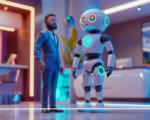Generative AI is transforming the creative landscape, making waves across various fields by creating new and original content. Unlike traditional AI, which focuses on analyzing and predicting based on existing data, generative AI generates entirely new content—be it text, images, music, or even video.
Take GPT-4, for instance. This advanced model can write articles, craft compelling stories, and generate marketing content that feels strikingly human. Similarly, tools like DALL-E can create stunning images from mere text descriptions, pushing the boundaries of visual art and design. This technology opens up exciting possibilities for artists, writers, and designers, allowing them to experiment with new ideas and accelerate their creative processes.
In business, generative AI is streamlining content creation and personalizing customer interactions. Companies are using AI to generate tailored marketing materials, automate responses, and even design products based on consumer preferences. This not only boosts efficiency but also enhances customer engagement by delivering highly relevant content.
However, the rise of generative AI also brings challenges. Issues such as the creation of deepfakes and the potential for misinformation are major concerns. Additionally, there are questions about how AI will impact jobs in creative fields, as these tools become increasingly capable.
Despite these challenges, generative AI’s potential is enormous. It offers new ways to innovate, create, and solve problems, blending human creativity with machine power. As we continue to explore and harness this technology, it promises to reshape our approach to creativity and content generation in profound ways.

















